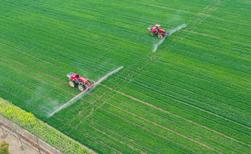 Farmers spray agrichemicals on a wheat field in Haian, Jiangsu province, on March 12, 2021. (PHOTO BY ZHAI HUIYONG / FOR CHINA DAILY)
Farmers spray agrichemicals on a wheat field in Haian, Jiangsu province, on March 12, 2021. (PHOTO BY ZHAI HUIYONG / FOR CHINA DAILY)
HEFEI/HARBIN-Luo Yingdi, 50, has been busy spraying pesticide in wheat fields for over a month, covering about 67 hectares of land per day with the help of his agricultural spraying tractors.
"I have six agricultural sprayers and two drones to spray pesticides and herbicides. Seven employees from my agricultural service company do the spraying work," said Luo, who has been farming for 21 years in Yingshang county, Anhui province. Besides looking after his 53 hectares of farmland, he also provides spraying services to other farmers.
Spring equinox, or chunfen in the Chinese lunar calendar, fell on March 20 this year. After spring equinox the days get longer, the weather warms up and crops grow fast.
On and around spring equinox, a major season for farming in China, agricultural activities are in full swing across the country, from the north to the south.
In Northeast China's Heilongjiang province, Li Fuqiang, 38, has stored enough fertilizer and soybean seeds for spring plowing. Li, who was awarded the title of "Soybean Master" in the province in 2018 for planting quality soybeans, plans to sow 3,333 hectares of non-GMO quality soybean this year.
Heilongjiang is China's largest soybean-producing region, accounting for about half the country's total soybean acreage. The acreage in the province exceeded 4.66 million hectares in 2020 and will remain stable this year, according to the provincial department of agriculture and rural affairs.
Upgrading agriculture
To complement the use of large agricultural machinery and even drones, Chinese researchers have developed a number of high-tech products to help farmers get better access to agricultural know-how, use intelligent management platforms and better control pests and plant diseases.
"I learned how to make better use of fertilizers and herbicides by watching an agricultural livestreaming show. I'm confident that I'll have a good harvest this year," said Jiang Deying from Baoqing county, Heilongjiang.
On Hongwei Farm the use of an intelligent agriculture platform supported by a monitoring system can increase rice yield by about 5 percent while also reducing the use of fertilizers by some 7 percent, said He Peixiong, director of the farm's agriculture department.
In Changfeng county, Anhui province, a group of researchers slowly walk through a wheat field, holding a selfie stick-like device upside down to look for pests.
ALSO READ: Toward smarter agriculture
The early identification and control of pests and plant diseases is critical to guaranteeing healthy crop growth. Agricultural scientists developed the pest recognition tool to help farmers handle pests more effectively.
Cultivating high-quality varieties with independent intellectual property can help enhance China's agricultural competitiveness, so as to ensure the country's food security.
Nie Shoujun, head of the Heilongjiang Academy of Agricultural Sciences
A camera is installed at one end of the device to capture images of pests and crop conditions. There are also sensors that record the real-time temperature and moisture of the field. All the data are uploaded to and processed in a server to evaluate the potential damage from pests and thus offer effective solutions to farmers.
"We developed pest-recognition software to analyze pictures the device takes in the fields and then tell farmers what kinds of pests they have to deal with," said Du Jianming, a researcher of the Institute of Intelligent Machines, which is part of the Chinese Academy of Sciences.
After nine years of data collection, over 1 million images of various pests and crop diseases have been captured. The technology can be applied in different crop fields including wheat, rice, corn and soybeans, with an accuracy rate of up to 85 percent. So far, it has been adopted in more than 10 provinces, according to the institute.
Ensuring food security
In a bid to identify the ideal rice varieties for Heilongjiang, a team headed by Nie Shoujun from the Heilongjiang Academy of Agricultural Sciences conducted a series of experiments. After years of efforts, a number of high-quality varieties featuring high yields and better resistance to disease have been cultivated.
"Cultivating high-quality varieties with independent intellectual property can help enhance China's agricultural competitiveness, so as to ensure the country's food security," Nie said.
As the COVID-19 pandemic continues to ravage the world, transnational trade in grains has often been disrupted, putting the global food supply chain at great risk. The number of people suffering from hunger is on the rise.
China reaped a bumper harvest last year despite the impact of COVID-19, typhoons, floods and droughts, with an annual grain yield of 669.5 million metric tons. The country has shown the capability to feed its population and withstand threats to grain production.
This year marks the beginning of China's 14th Five-Year Plan period (2021-25). China's Ministry of Agriculture and Rural Affairs has urged all provincial-level regions to either maintain or increase their crop planting area to make sure the country's total grain output stays above 650 million tons per year.
Heilongjiang plans to add 100,000 hectares of crop acreage this year, according to the provincial department of agriculture and rural affairs.
China has enjoyed a bumper harvest for 17 straight years, with its annual grain output exceeding 650 million tons for six consecutive years, boosting the country's confidence in fighting COVID-19 and developing the economy, said Li Guoxiang, a researcher with the Rural Development Institute of the Chinese Academy of Social Sciences.
READ MORE: Farm, tech shares lead strong rally
By meeting its domestic grain demand and reducing grain imports while moderately increasing exports of waheat and rice, China is making a contribution to the world in terms of reducing global food security risks, Li said.


